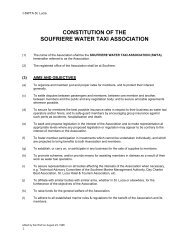WWF Cover photo - Soufriere Marine Management Association ...
WWF Cover photo - Soufriere Marine Management Association ...
WWF Cover photo - Soufriere Marine Management Association ...
You also want an ePaper? Increase the reach of your titles
YUMPU automatically turns print PDFs into web optimized ePapers that Google loves.
14. Tabarca <strong>Marine</strong> Reserve, SpainCo-authored by José Luis Sánchez Lizaso, University of Alicante, Spain JL.Sanchez@ua.esTabarca Island is a few kilometres off the Mediterranean coast of Spain, close to Alicante. It is small (0.7 km 2 )with a permanent population of just 50 people, but receives between two and five thousand visitors per day insummer. The main sources of income for residents are artisanal fishing and tourism. Habitats around the islandare dominated by seagrass beds of Posidonia oceanica to 30m depth (Ramos et al. 1992). The 1400ha Tabarca<strong>Marine</strong> Reserve was established in 1986 and is divided into three use zones: a 100ha core area that is no-take, abuffer zone where some traditional fishing gears are permitted and a recreational zone where diving and otherrecreational activities are permitted, and some forms of fishing. Spear-fishing, boating and waterskiing are notallowed anywhere in the reserve. The reserve is marked using buoys and enforced by four rangers with twopatrol boats. It is managed by a committee with representatives of the national and local government, the localcouncil, fishers, researchers, the local scuba-diving organisation, environmental organisations and communitygroups (Sánchez Lizaso et al. 2001).Eighty percent of the seabed within the marine reserve is covered in seagrass. To prevent damage to seagrassbeds by illegal otter-trawl fishing an anti-trawling artificial reef has been installed in the marine reserve and anumber of old boats sunk. These artificial reefs appear to have been successful in reducing illegal trawling. Atanother site in the area, El Campello, an anti-trawling reef on seagrass has led to increased catches of the redmullet, one of the main target species for the recreational fishery (Martínez-Hernandez 1997). Two mooringareas were also designated to reduce the impact of visitors anchoring in seagrass areas (Sánchez Lizaso et al.2001).Underwater surveys have shown that abundance and biomass of fish are higher in the reserve than in unprotectedareas and most target species such as Epinephelus spp. (groupers), Sciaena umbra (brown meagre – Sciaenidae),Diplodus spp. and Dentex dentex (seabreams – Sparidae) have increased in abundance and biomass in thereserve since 1988 when they were first surveyed (Sánchez Lizaso et al. 2001). Exploited invertebratepopulations have also recovered. At the outset of management the pen shell Pinna nobilis had virtuallydisappeared from the area, as a result of collection by divers as a curio. Now, densities are 12 times higher in thereserve than in nearby areas. Populations of octopus, squid and lobster (Palinurus elephas) have also increased(Ramos et al. 1992). The researchers saw improvements in the deeper seagrass habitat in the marine reserve,with a significant increase in seagrass cover in deeper waters between 1988 and 1992, but no change in shallowseagrass cover (Sánchez Lizaso et al. 2001).Ramos et al. (1992) found that catches of a number of key species increased in fishing areas adjacent to thereserve. The catch of grouper increased by 50%, gilt-headed seabream (Sparus auratus) by 60% and bream(Dentex dentex) by 85% after 6 years of protection. Mas and Barcala (1997) confirmed these trends, finding thatwhile total catches from the Tabarca area remained constant after the creation of the reserve, CPUE was highernear to the reserve than in other fishing grounds in the area. They found that catches of the bream Dentex dentexhad increased by more than three fold after 9 years of protection (Figure 1).The socio-economic status of the local fishing fleet is good compared to other fleets in the area. The Tabarcafleet is now the most modern in the region and is the only fleet in which numbers of fishers are not decreasing(Sánchez Lizaso and Giner 2001). In response to the improved viability of fishing with inshore trap nets sincethe establishment of the reserves, local fishers have set up a co-operative to fish with this gear, and after initialscepticism, their support for the area is improving.Diving in the reserve is strictly controlled, and the number of divers permitted to dive the reserve per day hasbeen reduced in response to pressure from fishers. Other forms of tourism have been increasing over recent yearsand many tourists come to visit the beach and village, rather than for water-based activities. A number of generalbenefits have accompanied development of the reserve including improvements in transport to and from theisland, garbage disposal, electricity supply and other infrastructure (Sánchez Lizaso et al. 2001).At another marine reserve around small offshore Spanish islands, the Columbretes Islands <strong>Marine</strong> Reserve, Goñiet al. (2001a,b) found significantly higher catch rates of red lobster (Palinurus elephas) from experimentalfishing inside the Columbretes <strong>Marine</strong> Reserve, compared to two fished sites outside the reserve. The catch rateinside the reserve was between 15.1 and 29 lobsters per 40 traps, whereas outside the reserve the catch rate was0-2.5 lobsters per 40 traps (Goñi et al. 2001a). The reserve covers 14 km 2 and lies 50km off the coast of Spainand has been protected since 1990. No quantitative data are available on the direct effects of the reserve on localfisheries but a fishery has developed around its boundary, suggesting that fishers are seeing spillover from the83



